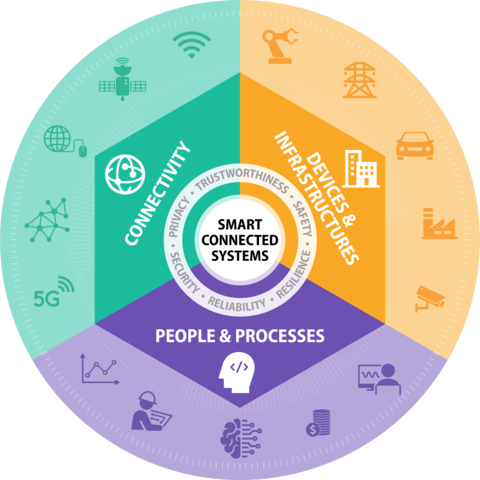Technical Foundations for Smart Connected Systems

The Smart Connected Systems Division (SCSD) has developed a series of foundational systems engineering frameworks, often published as NIST Special Publications, which provide vision, insights, principles, organizing structures, and voluntary guidance and best practices to help advance broad technical sector-based areas of engagement in cooperation with our stakeholders. As a non-regulatory federal agency with a mission to promote U.S. innovation and industrial competitiveness, NIST has a long history of successfully addressing critical national issues through partnerships with industry, academia, and other government agencies. SCSD and its collaborators have led such efforts through industry outreach, public technical working groups, workshops, frameworks, and standards activities.
One of NIST’s original frameworks is the NIST Framework and Roadmap for Smart Grid Interoperability Standards, Release 1.0, developed in response to the Energy Independence and Security Act of 2007 (EISA), which gave NIST “primary responsibility to coordinate development of a framework that includes protocols and model standards for information management to achieve interoperability of smart grid devices and systems." Our Smart Grid Program (and SCSD Smart Grid Group), in partnership with other NIST Laboratories and external stakeholders, has led the effort over many years to periodically revise the NIST Smart Grid Interoperability Framework to reflect new industry conditions and technology advancements. Our most recent NIST Framework and Roadmap for Smart Grid Interoperability Standards, Release 4.0, is a major revision: it introduces new Communication Pathways Scenarios and an ontology for the smart grid; introduces new concepts in grid operations and economics; provides guidance on cybersecurity practices and tools; and develops the concept of Interoperability Profiles to support grid functionality and facilitate testing and certification.
Another foundational framework is NIST’s Framework for Cyber-Physical Systems (or NIST CPS/IoT Framework), consisting of 3 volumes: Volume 1, Overview (SP 1500-201); Volume 2, Working Group Reports (SP 1500-202); and Volume 3, Timing Annex (SP 1500-203). NIST CPS/IoT Framework development is led by the SCSD IoT Devices and Infrastructure Group, and it builds on completed efforts in the NIST-established CPS Public Working Group to define and shape key characteristics of CPS and IoT, to better manage development and implementation within and across multiple smart application domains. The resulting NIST CPS/IoT Framework provides an organized presentation of a CPS analysis methodology based on the core concepts of Facets (modes of the system engineering process: conceptualization, realization, and assurance) and Aspects (clusters of concerns: functional, communications, business, human, trustworthiness, timing, data, composition, boundaries, and lifecycle). As described in NIST Special Publication 1900-202 Cyber-Physical Systems and Internet of Things, CPS and IoT concepts are converging, and a unifying definition is presented: CPS and IoT comprise interacting logical, physical, transducing, and human components engineered for function through integrated physics and logic.
The SCSD IoT Devices and Infrastructure Group also has its Smart Cities and Communities Framework (SCCF), consisting of a series of best practices and technical guidelines for the planning, developing, and implementing of standards-based solutions in communities. Industry stakeholders, community leaders, and the research community can use the NIST SCCF as a reference to further their innovation and product development goals, and to improve the quality of service and ultimately the quality of life for community residents. The target audience includes city and community officials, technology innovators, researchers, project planners and managers, and other implementers. In the recent NIST Special Publication 1900-206 Smart Cities and Communities: A Key Performance Indicators Framework, “smart” is defined as the efficient use of digital technologies to provide prioritized services and benefits to meet community goals. This NIST Holistic Key Performance Indicators (H-KPI) Framework provides three interacting levels of analysis: technologies, infrastructure services, and community benefits. The Framework also describes a H-KPI method with five core metrics: alignment of KPIs with community priorities across districts and neighborhoods; investment alignment with community priorities; investment efficiency; information flow density; and quality of infrastructure services and community benefits.
In the critical area of cybersecurity for operational technologies, the SCSD Networked Control Systems Group in collaboration with the Information Technology Laboratory has produced several revisions of NIST Special Publication 800-82 which serves as a de facto worldwide standard or guideline for ICS security. The most recent version, SP 800-82r3 Guide to Operational Technology (OT) Security Revision 3 provides guidance on how to improve the security of OT systems while addressing their unique performance, reliability, and safety requirements. SP 800-82r3 provides an overview of OT and typical system topologies, identifies typical threats to organizational mission and business functions supported by OT, describes typical vulnerabilities in OT, and provides recommended security safeguards and countermeasures to manage the associated risks. The SP 800-82 publications have been downloaded more than 3 million times since its initial release in 2006.
Another SCSD foundational systems engineering contribution is in the field of automated driving: NIST Special Publication 1900-301 Automated Driving System Safety Measurement Part I: Operating Envelope Specification. In this work, the IoT Devices and Infrastructure Group introduces the concept of an operating envelope specification (OES), a structured description of the operating environment for driving, which builds on the existing concept of operational design domain (ODD) in which automated driving systems are designed to function. The OES supports calculation-based reasoning for vehicle performance in that environment, with testing and certification applications and in real-time driving. The NIST approach resulted from an open stakeholder engagement process in the NIST ADS Safety Measurement Technical Working Group, which was initiated based on stakeholder input at the NIST Workshop on Consensus Safety Measurement Methodologies for Automated Driving System-Equipped Vehicles and open to all interested parties, including manufacturing, transportation, research and development, government, and roadway design participants. SCSD’s IoT Devices and Infrastructure Group and the Transformational Networks and Services Group are working collaboratively to advance foundational concepts in automated driving safety and teleoperation, including through contributions to the NIST Workshop on Standards and Performance Metrics for On-Road Autonomous Vehicles.

